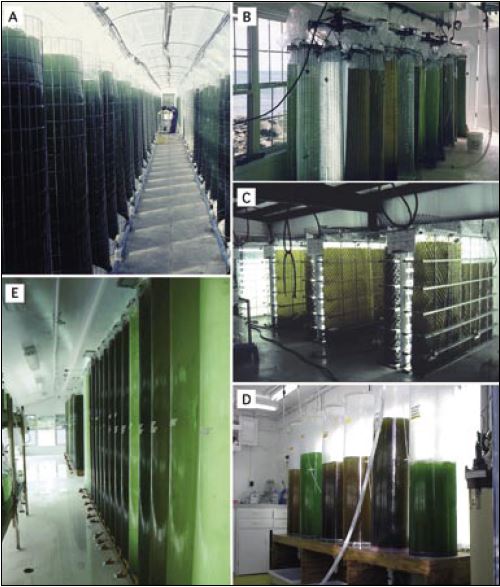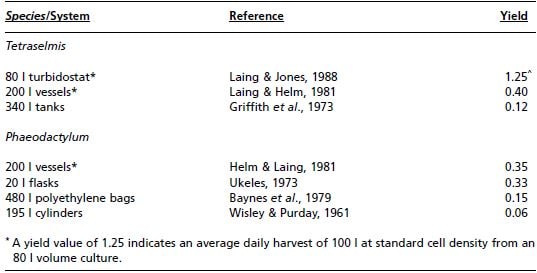3.4.1 Bag and cylinder cultures
Polyethylene can be purchased as heavy gauge, “lay-flat” tubing in various widths and in rolls containing convenient lengths. By cutting a suitable length and heat-sealing one end a sterile, flexible culture container can be formed, either as a cylinder or as an oblong bag. Containers formed in this way can be strengthened by supporting them within a plastic or plastic coated steel mesh frame.
Alternatively, the cylinders can be suspended, with or without lateral support mesh, if the diameter of the bag is less than 30 cm and the height less than 200 cm. Examples are shown in Figure 24.

Figure 24: Examples of polyethylene bag and solar grade, fibreglass cylinder algal culture systems: A – 480 l polyethylene bags supported inside steel mesh frames and illuminated by natural light within a greenhouse. B – 80 l bags suspended around a circular central framework on a rotating, ceiling mount. Fluorescent lamps are attached to the central framework. C – plastic mesh supported, oblong polyethylene bags mounted either side of banks of fluorescent lamps. D – 100 l solar grade, fibreglass cylinders against a bank of vertically mounted fluorescent lamps. E – 2.4 m high, 0.3 m diameter fibreglass cylinders, externally illuminated by vertically mounted 2.4 m length fluorescent lamps.
Bags are the least expensive way of constructing large-scale culture vessels and such containers can be used indoors with artificial illumination or outdoors taking advantage of natural light. The bags illustrated in Figure 24A are formed from lengths of 10 000 gauge, extra heavy duty, 90 cm width polyethylene tubing. They are supported by welded steel mesh frames and have a capacity of 480 l with a large surface area of 3.2 m2
for light penetration. Large cultures of this type can be illuminated by vertically mounted 1.8 m long, 80 W fluorescent lamps or can be sited outdoors, out of direct sunlight. Bag systems shown in Figure 24B and C are formed from the same material but are supported by sturdy, plastic mesh.
In general, the larger the diameter of the culture vessel, the lower is the maximum cell density possible with a fixed level of illumination. Nevertheless, these bags are superior in productivity to similar volume rectangular, fibreglass or plastic tanks sometimes still used for mass culture. They are, however, inefficient when compared with internally illuminated cultures as can be seen in yield data given in Table 7.
Polyethylene bag cultures have a relatively short life because the internal surface attracts culture debris and bacteria, which collectively reduce light penetration and are a source of contamination. At the end of a culture run it is necessary to renew the bag. Large diameter bags are inefficient but those less than 30 cm diameter can be effective because the surface area to volume relationship for light penetration is improved.
A more permanent solution to the same principle is offered by solar grade, transparent fibreglass sheet that can be formed into a cylinder and solvent welded or purchased in cylindrical form. The light penetration qualities of this material are excellent and the vessels so constructed are durable. Cylinders that are 150 to 240 cm high and 30 to 50 cm in diameter are commonly used in North American hatcheries (Figure 24D and E).
Table 7: Comparison of yields of Tetraselmis and Phaeodactylum from various large-scale culture systems. Yield is calculated as litres per day at a standard cell density per litre of culture volume. (* Internally illuminated systems). References quoted are given in full in the suggested reading list at the end of this section.

* A yield value of 1.25 indicates an average daily harvest of 100 l at standard cell density from an 80 l volume culture.